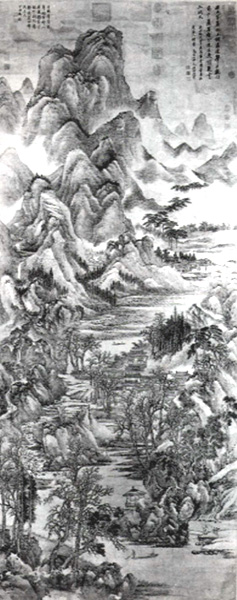Introduction
It is important to note that Chinese art has a range of unique attributes and characteristics. A Thousand Peaks and Myriad Ravines is a painting by Wang Hui, which exemplifies this uniqueness by providing both the landscape tradition of the use of Chinese ink as well as a short poem accompanying it. By observing the artwork, it is evident that neither the words nor the image is effective in conveying the scene. The main reason is that they are meant to work together, communicating a range of visual, auditory, and other sensual signals to the viewer.
Discussion
Figure 1 below showcases the artwork titled A Thousand Peaks and Myriad Ravines by Wang Hui. A closer observation provides a deep and rich visual experience of the landscape envisioned by the artist. The sole use of ink seems intentional in order to deprive the image of color to leave the gap to be filled in by another element. Chinese ink art essentially forces an artist to be more imaginative and creative in conveying landscape details through shadows, shadings, details, and lines. However, it still conveys only rich but partial visual stimuli to a viewer. The accompanying poem inscribed on the image provides more contextual as well as sensual information to enrich the experience of art appreciation. By mentioning the weeds and moss, the author communicates minute and intricate details missing in the image since the landscape’s scale is too large to depict these smaller elements. The sound of dripping water provides a piece of additional auditory information, which further turns the static image into a dynamic reality. Flowers and caves enable a greater stimulation of the sense of smell and depth of the artwork.
Therefore, neither the words nor the image is effective in conveying the scene because they complement each other by filling the gaps correspondingly. They work together exceptionally well by communicating a range of visual, auditory, and other sensual signals to the viewer. The poem provides the missing details, such as minute elements, sounds, smell, and depth of the image, whereas the art itself can focus on the grandiosity of the landscape and its scale. The combination perfectly represents the ideals of the scholar in Chinese art called wenren, meaning literati (Wikimedia, 1693). There are strong aspects of Daoism when it comes to reuniting with nature and the universe through the creation of paintings, poetry, and gardens. In other words, A Thousand Peaks and Myriad Ravines by Wang Hui is an example of a literati painting inspired by the principles and philosophy of Daoist art.

Conclusion
In conclusion, it is clear that neither the words nor the image is more effective in conveying the scene, and they work together to communicate a range of visual, auditory, and other sensual signals. By observing the artwork, Chinese ink art still conveys only rich but partial visual stimuli to a viewer. However, the accompanying poem inscribed on the image provides more contextual as well as sensual information to enrich the experience of art appreciation. Flowers add smell, caves provide depth, moss and weeds detail the image, and the image focuses on the grandiosity and scale of the landscape. In addition, there are strong aspects of Daoism when it comes to reuniting with nature and the universe through the creation of paintings and poetry.
Reference
Wikimedia. (1693). A Thousand Peaks and Myriad Ravines. Web.